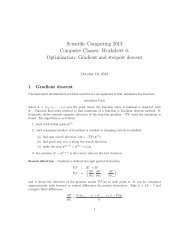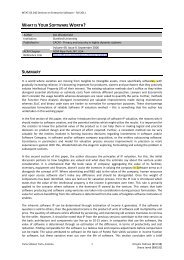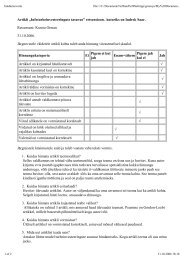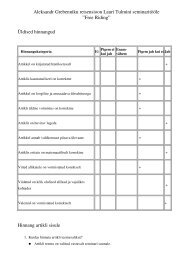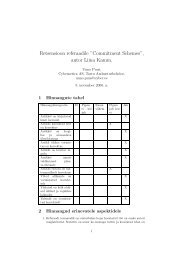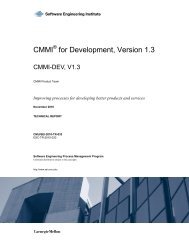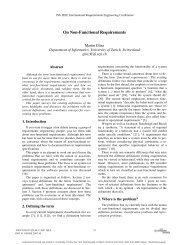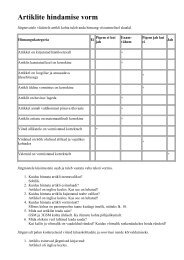Software Pricing
Software Pricing
Software Pricing
Create successful ePaper yourself
Turn your PDF publications into a flip-book with our unique Google optimized e-Paper software.
MTAT.03.244<br />
<strong>Software</strong> Economics<br />
Session 10: <strong>Software</strong> <strong>Pricing</strong><br />
Marlon Dumas<br />
marlon.dumas ät ut . ee
Readings of previous weeks<br />
• Week 9: Hal R. Varian.<br />
Economics of Information Technology. Draft<br />
paper, 2003.<br />
• Week 10: Neil Davidson. Don't just roll the dice.<br />
Online book, 2009.<br />
2
Outline<br />
• Economic Factors of <strong>Software</strong> <strong>Pricing</strong><br />
• Case Study: Nuway <strong>Software</strong><br />
Warning: This is a discussion-oriented class, if<br />
you don’t discuss, there’s no class…<br />
3
Information Goods<br />
• <strong>Software</strong> products have an unusual cost structure:<br />
– High fixed costs of production<br />
– Low or zero variable costs of production<br />
• Example: a well-known software company spends<br />
100s of millions of dollars developing each version<br />
of its OS. Once a first copy of the OS has been<br />
developed, it can be replicated almost costlessly.<br />
• This cost structure characterizes a class of<br />
technology products termed information goods.<br />
• It includes software, but also video, music, books,<br />
…<br />
4
<strong>Software</strong> versus Information Goods<br />
• In addition to being an Information Good,<br />
software has additional characteristics:<br />
– Sometimes needs to be developed uniquely for a<br />
customer<br />
– Can be useless without other elements such as<br />
training, support, configuration, or business process<br />
change<br />
– Sometimes highly tied to data (e.g. mapping software)<br />
– <strong>Software</strong> is often stacked on top of software…<br />
5
<strong>Pricing</strong> Strategies<br />
• Cost-plus pricing (e.g. consultancy, reseller)<br />
• Value-based pricing<br />
– Maximize revenue (to build market share)<br />
– Maximize profit (rational strategy – more later)<br />
• Target return pricing<br />
– Achieve revenue or quantity target<br />
– Achieve profit target<br />
• Psychological pricing<br />
– “Quality” leadership pricing<br />
– “Discount” pricing<br />
6
<strong>Pricing</strong> Models<br />
• <strong>Pricing</strong> strategy is meant for our internal<br />
decision-making<br />
• In addition to a pricing strategy, we need a<br />
pricing model so that we can explain our pricing:<br />
– Fixed-fee pricing<br />
– Price discrimination<br />
– Bundling<br />
7
• Flat perpetual fee<br />
• Flat periodic fee<br />
Fixed-fee <strong>Pricing</strong><br />
• When to choose which?<br />
• What price should we charge?<br />
– Depends on the cost,<br />
• Fixed cost (once incurred, it becomes a “sunk cost”)<br />
• Variable cost (e.g. support services)<br />
• Maintenance cost!<br />
– But also on the demand curve, see example at:<br />
http://www.joelonsoftware.com/articles/CamelsandRubberDuckies.html<br />
8
Fixed-fee <strong>Pricing</strong> (cont.)<br />
• Limitations of fixed-price<br />
– Does not take into account customization / assumes<br />
all customers are the same<br />
– Does not capture consumer surplus (good and bad)<br />
• Leads to price discrimination…<br />
9
Price Discrimination<br />
• First-degree price discrimination<br />
– Price depends on the customer<br />
– Mass customization / personalization<br />
– Does it apply to software?<br />
• Second-degree price discrimination<br />
– Price depends on “product variant”<br />
• E.g. Adobe Acrobat<br />
– Price differentiation based on quality or usage/volume<br />
• E.g. volume licensing, usage licensing, site licensing<br />
10
Price Discrimination (cont.)<br />
• Third-degree price discrimination<br />
– Different prices for different groups of users<br />
– Examples: private users versus commercial users,<br />
student/academic licenses, geographical regions…<br />
– Can you think of others?<br />
• Price discrimination based on purchase history<br />
– Old versus new customers<br />
– Upgrades versus new licenses…<br />
11
Bundling<br />
• Selling multiple goods for a single price<br />
• Example: what software am I using now?<br />
• Sometimes, software and hardware are<br />
bundled…<br />
• Sometimes (perhaps not often enough),<br />
software is sold with guarantees it will work…<br />
12
External Factors of <strong>Software</strong> <strong>Pricing</strong><br />
• Competition of course, including open-source<br />
• Lock-in, switching costs, standards<br />
• Piracy<br />
• Network effects:<br />
– Demand for a good depends on how many people<br />
acquire it, e.g. 3G mobile phone, Skype, …<br />
• System effects:<br />
– Some products are useless unless they are combined<br />
with other products to form a system, e.g. products<br />
without support and training may be useless<br />
13
Case Study: “Nuway <strong>Software</strong>”<br />
• Nuway is a 4-year-old company selling highly<br />
customized software, but based on common<br />
toolkit<br />
• Products sold are non-mission-critical<br />
• <strong>Pricing</strong> model based on cost + margin (costplus)<br />
• Should Nuway start selling its Nulogic toolkit as<br />
a software package and with what pricing<br />
strategy?<br />
14
Class Discussion (in groups)<br />
• Enumerate arguments for and against productbased<br />
marketing of Nulogic? Do you favour or<br />
oppose this move? What additional information<br />
would be helpful in making a decision?<br />
• If Nulogic was marketed as a software package,<br />
what pricing model would you adopt?<br />
• If Nulogic was not marketed, what other<br />
opportunities exist to capitalize on the existing<br />
Nulogic investment?<br />
15
Homework<br />
<strong>Pricing</strong>/Business Model Analysis<br />
• See “Assignments” page on course’s Web site<br />
• To be completed in teams of 2-4 members<br />
• Worth 5 points<br />
• Report due 29 November at 10:15am<br />
• To be submitted via e-mail<br />
16
Further Reading<br />
• Paper by Rajala, Rossi & Tuunainen:<br />
A Framework for Analyzing <strong>Software</strong> Business<br />
Models. In Proceedings of the European<br />
Conference on Information Systems (ECIS),<br />
June 2003.<br />
• Informal discussion board on “The Business of<br />
<strong>Software</strong>”:<br />
– http://discuss.joelonsoftware.com/default.asp?W1341<br />
17



